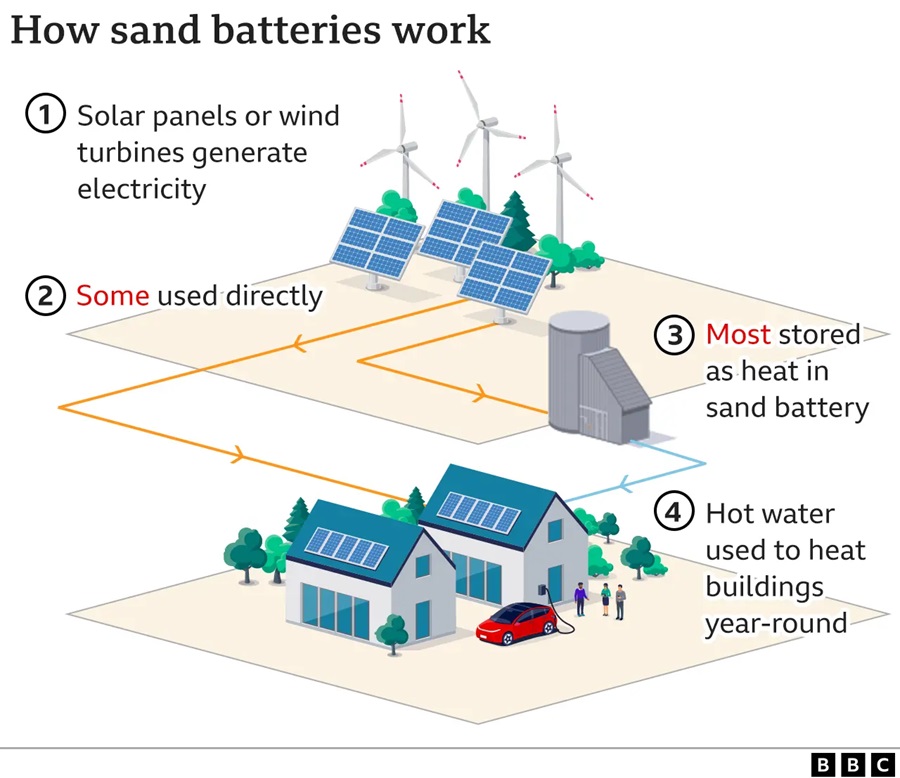Finnish company Polar Night Energy has developed the world’s first operational ‘Sand Battery’ to provide an affordable and environmentally friendly source of storing renewable energy.
The system has been installed in the Vatajankoski power plant which runs the district heating system for the area. The battery utilizes sand as a heat reservoir and seamlessly integrates into the local district heating network, catering to approximately 10,000 residents.
World’s First Commercial Sand Battery at Vatajankoski
The Vatajankoski power plant is home to the world’s first commercial-scale sand battery. The world’s first commercial sand-based energy storage system (sand battery) was inaugurated in Vatajankoski, Kankaanpää in January 2023 after testing in 2022.
The storage has 100 kW heating power and 8 MWh capacity. The full-scale utilization of the storage began during the year 2022.
- Polar Night Energy’s sand-based heat storages convert electricity to heat, and store it for later use.
- Using low-grade sand, the device is charged up with heat made from cheap electricity from solar or wind.
- At a maximum 600C constant temperature, the sand battery can store 8 megawatts of thermal energy, which is enough to provide heating and hot water to about 100 homes.

The project was launched at a time when Russia cut off gas supplies in retaliation for Finland joining NATO, depicting a timely example of how renewable energy could be used in different ways.
Industrial-scale Sand Battery in Pornainen
Now, Polar Night Energy and the Finnish district heating company, Loviisan Lämpö, have signed an agreement to build an industrial-scale Sand Battery in Pornainen for Loviisan Lämpö’s district heating network.
The industrial-scale storage unit in Pornainen, southern Finland, will be the world’s biggest sand battery when it comes online within a year.
The heating power of the new Sand Battery is 1 MW and it can store up to 100 MWh of thermal energy, making it about 10 times larger than the Sand Battery in operation in Kankaanpää since 2022.
The 1 MW Sand Battery is capable of storing up to 100 MWh of thermal energy from solar and win sources, meeting nearly one month of summer heating demand and one week of winter demand in Pornainen.
The purpose of the Sand Battery is to reduce carbon dioxide emissions and introduce a new flexible heat production technology. “Loviisan Lämpö is moving towards more environmentally friendly energy production. With the Sand Battery, we can significantly reduce energy produced by combustion and completely eliminate the use of oil,” says Mikko Paajanen, CEO of Loviisan Lämpö.
“It’s exciting to build a large-scale thermal energy storage, which will also act as a primary production plant in Pornainen’s district heating network,” says Liisa Naskali, COO at Polar Night Energy, the company behind the innovation. “This is a significant step in scaling up the sand battery technology.”
The Sand Battery is set to integrate with Loviisan Lämpö’s district heating network and draw power from the electric grid, utilizing Polar Night Energy’s specially crafted charging algorithms. These algorithms are designed to minimize electricity costs while meeting district heating needs.
The Sand Battery for Loviisan Lämpö will be approximately 13 meters high and 15 meters wide. Development and construction of the system are anticipated to take around 13 months. The company said that crushed soapstone, a byproduct of heat retaining fireplaces. will serve as the storage medium, typical for sand batteries which utilize sand or sand-like materials for storage.
The battery will also help to reduce annual carbon dioxide emissions from the district heating network of Pornainen by nearly 70%, according to Polar Night Energy. Liisa Naskali, the COO of Polar Night Energy, said the project is “a significant step in scaling up the sand battery technology.”
What is a sand battery?
A “sand battery” is a high temperature thermal energy storage that uses sand or sand-like materials as its storage medium. Primarily, it aims to provide a high-power, high-capacity solution for storing excess energy.
It works by converting the captured renewable electricity into hot air by using an industrial version of a standard resistive heating element, then directing the hot air into the sand. The heat transfers from the air to the sand, which ends up at temperatures of around 500 to 600 degrees Celsius. To unlock it for use, the process is reversed and the hot air funneled into a heating system used for homes or industry.
Its main purpose is to work as a high-power and high-capacity reservoir for excess wind and solar energy. The energy is stored as heat, which can be used to heat homes, or to provide hot steam and high temperature process heat to industries that are often fossil-fuel dependent.
How Sand Battery can help transition to clean energy?
The company behind the technology, Polar Night Energy, aims to solve one of the key obstacles in the transition to full renewable energy, which is how to store it for use during times when the sun is not out or wind isn’t blowing.
Polar Night Energy’s sand-based heat storages offer a cost-effective and clean surplus electricity when most needed, especially during the long Nordic nights. The solution is simple, sustainable and also abundant as the planet has plenty of sand.
Polar Night Energy’s sand battery stores heat for use weeks or even months later. The process has been described as low-cost and the main costs are related to equipment and construction of the steel storage tank.
Since no chemical reaction takes place, this system is non-flammable, easy and affordable to maintain and has a much lower environmental impact than lithium-ion alternatives.